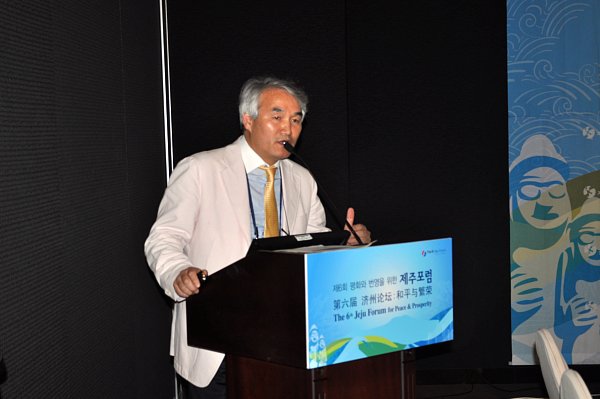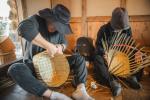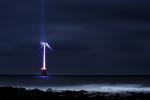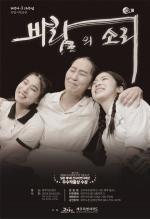- Dispatch 3 from the 6th Jeju Forum for Peace & Prosperity, May 27-29
[May 27, 11:30 p.m.]
The Jeju Weekly currently has reporters at the forum venue covering a wide range of talks, sessions and panels. We will be posting brief reports on our Web site throughout the weekend, and then compile them into a comprehensive report for Issue 51 of The Weekly as well as in our Chinese edition. -- Ed.
The 6th Jeju Forum for Peace and Prosperity, hosted at the Haevichi Hotel & Resort in Pyoseon, Seogwipo City, began on May 27 at 2 p.m. with five concurrent presentations of 16 scheduled for the day. A total 63 conferences will occur over the three-day period.
The forum, organized by several national and provincial organizations, will be conducted under the theme of “New Asia for Peace and Prosperity,” with the purpose of expanding previous years’ topics of discussion from specifically concerning the notion of peace to subject matters that directly affect its establishment like economics, environmental concerns, and cultural issues.
This expansion highlights great changes to the forum. Established in 2001 to continue the efforts of the June 2000 North-South Summit, the Jeju Peace Forum was originally a biennial event, but was changed this year for the purpose of creating a globally recognized forum where ideas are continually discussed and worked towards. Jeju Peace Foundation President Han Tae Kyu has said that the year between forums resulted in a lag in implementing the ideas and proposals discussed during the conference and now that it has been expanded to a yearly event it will help to foster multilateral communication in Asia.
Some of the topics to be discussed on Friday, May 27, are International Cooperation for Peaceful and Ecological Conservation and Utilization of DMZ, The Korean Wave (Hallyu) and Cultural Fusion in East Asia: Toward an East Asian Cultural Community, World Natural Heritage and Environmental Conservation, among other issues.
The “International Cooperation for Peaceful and Ecological Conservation and Utilization of the DMZ,” one of five panel discussions that kicked off the 6th Jeju Forum for Peace & Prosperity on May 27, focused on the DMZ’s ecological value and its potential as a bridge between North and South Korea that could foster a peaceful and beneficial relationship for both sides.
“If we look at the positive aspect [of the DMZ],” said Korea DMZ Council Chairman and Emeritus Professor at Seoul National University Kim Kwi Gon, “there is abundance of ecology and it is also a remnant of the Korean War.”
The DMZ is a strip of land that divides the two Koreas, and since it has been a restricted area to civilians for roughly 50 years, its ecology has been allowed to flourish. Kim, who has traveled in the restricted area several times to document its wildlife, said that before the war it was predominately covered with rice paddies, but due to the ban those areas have now become wetlands and are now home to an abundant ecology that includes migratory birds and endangered plants and animals.
It is an “ecological supermarket, a laboratory, some say a gift from heaven,” said Kim who is in the process of trying to have the area designated as a biosphere reserve.
The barrier Kim is encountering in trying to get Biosphere designation has to do with the lack of communication with the North.
Son Gi Woong, secretary General of the Korea DMZ council and the second to speak during the conference said that the conservation of the area and strategies for reunification are “intertwined.”
“In order for the two Koreas to coexist and deal with the environmental problems and prepare for unification, we need to deal with the DMZ in a peaceful matter,” Son said.
Son believes that since the preservation of DMZ’s ecology is in both parties interest, it is a vehicle that can be utilized to open up the lines of communication. He said that to deal with the DMZ “Environmental issues have to be at the center,” of the conversation, pushing political and economical differences to the way side.
For this to come about, Son said that the DMZ is not solely an issue of the peninsula, but one that deserves international support. “An example of it being an international issue is if North Korea begins to burn coal it could pollute the area,” said Son, which would be a detriment of a potential tourist industry, and most devastating, a loss of important ecology.
Hahm Kwang Bok, director of National Affairs and director general of the Korea DMZ Research Center addressed the issue of landmines during his talk titled “Korean-versioned Landmine Removal ‘Reborn Flower Campaign.’”
Currently, Hahm said, there are more than 1.12 million landmines in DMZ and since the end of the Korean War 3,000 people have died as a result of these mines.
He said that humans are not the only ones who are victims to landmines but that every year there are forest fires with the DMZ, and though it cannot be confirmed, it is assumed that the cause is “landmines that have been stepped on by animals.”
To remove all the landmines in South Korea, Hahm said, would take over 375 years.
Hahm suggests that Korea reinstate the “Born Flower” campaign collects money from private and government organizations to dig up the landmines and in their place plant a tree, which will be christened as a “Peace Tree.”
Already once tried, it failed to be fully realized but, “I am suggesting we launch this kind of program again, to let these landmines bloom into flowers,” said Hahm.
Moon Seong Mook, director of Inter-Korean Affairs and former head representative of Inter-Korean Working-Level Military Meetings, adds other possibilities to preserve and utilize the DMZ.
In his presentation, “The Development of North and South Korea’s Relations through a Peaceful Use of the De-militarized Zone,” Moon suggested three approaches for North and South Korea to jointly use the DMZ.
The first one is to “cooperatively excavate of the remains from the Korean War.” This, Moon said, would be a humanitarian effort that could bring the two Korea together.
The second possibility would be to use the DMZ to co-host the Military World Games, which he
said would be “very useful.”
Thirdly, to expand railways through to china, before so far there has been a “lack of interest on the park of North Korea,” for either of these projects.
Moon said that these three applications would relax tensions between the both sides, expand cooperation, and would allow for groundwork for reunification.
During an interview with Son Gi Woong after the conference he elaborated that the Biosphere reserve designation is a future goal and that it cannot be realized anytime soon. “In this first stage it is impossible,” he said, continuing that they have to take it one step at a time, but a conversation with North Korea about the conservation of the DMZ may open a new “channel” for dialogue.
“Ecological cooperation will be easier than military,” he said.
At the moment this channel seems far on the horizon. Son and his organization, the Korea DMZ Council, has sent several proposals and invites to North Korea, “but it is a difficult situation and we [can] not move further.” This is partially due to the military confrontations of last year which saw the sinking of the Cheonan submarine in March which killed 46 seamen, and the shelling of Yeonpyeong in November which resulted in four civilian casualties.
Though they are still hopeful of establishing communication with their neighbors in the north. “We plan next month to visit North Korean … and we wait their reaction,” said Son.
The Jeju Weekly currently has reporters at the forum venue covering a wide range of talks, sessions and panels. We will be posting brief reports on our Web site throughout the weekend, and then compile them into a comprehensive report for Issue 51 of The Weekly as well as in our Chinese edition. -- Ed.
The 6th Jeju Forum for Peace and Prosperity, hosted at the Haevichi Hotel & Resort in Pyoseon, Seogwipo City, began on May 27 at 2 p.m. with five concurrent presentations of 16 scheduled for the day. A total 63 conferences will occur over the three-day period.
The forum, organized by several national and provincial organizations, will be conducted under the theme of “New Asia for Peace and Prosperity,” with the purpose of expanding previous years’ topics of discussion from specifically concerning the notion of peace to subject matters that directly affect its establishment like economics, environmental concerns, and cultural issues.
This expansion highlights great changes to the forum. Established in 2001 to continue the efforts of the June 2000 North-South Summit, the Jeju Peace Forum was originally a biennial event, but was changed this year for the purpose of creating a globally recognized forum where ideas are continually discussed and worked towards. Jeju Peace Foundation President Han Tae Kyu has said that the year between forums resulted in a lag in implementing the ideas and proposals discussed during the conference and now that it has been expanded to a yearly event it will help to foster multilateral communication in Asia.
Some of the topics to be discussed on Friday, May 27, are International Cooperation for Peaceful and Ecological Conservation and Utilization of DMZ, The Korean Wave (Hallyu) and Cultural Fusion in East Asia: Toward an East Asian Cultural Community, World Natural Heritage and Environmental Conservation, among other issues.
 |
||
| ▲ Photo by Darryl Coote. | ||
The “International Cooperation for Peaceful and Ecological Conservation and Utilization of the DMZ,” one of five panel discussions that kicked off the 6th Jeju Forum for Peace & Prosperity on May 27, focused on the DMZ’s ecological value and its potential as a bridge between North and South Korea that could foster a peaceful and beneficial relationship for both sides.
“If we look at the positive aspect [of the DMZ],” said Korea DMZ Council Chairman and Emeritus Professor at Seoul National University Kim Kwi Gon, “there is abundance of ecology and it is also a remnant of the Korean War.”
The DMZ is a strip of land that divides the two Koreas, and since it has been a restricted area to civilians for roughly 50 years, its ecology has been allowed to flourish. Kim, who has traveled in the restricted area several times to document its wildlife, said that before the war it was predominately covered with rice paddies, but due to the ban those areas have now become wetlands and are now home to an abundant ecology that includes migratory birds and endangered plants and animals.
It is an “ecological supermarket, a laboratory, some say a gift from heaven,” said Kim who is in the process of trying to have the area designated as a biosphere reserve.
The barrier Kim is encountering in trying to get Biosphere designation has to do with the lack of communication with the North.
Son Gi Woong, secretary General of the Korea DMZ council and the second to speak during the conference said that the conservation of the area and strategies for reunification are “intertwined.”
“In order for the two Koreas to coexist and deal with the environmental problems and prepare for unification, we need to deal with the DMZ in a peaceful matter,” Son said.
Son believes that since the preservation of DMZ’s ecology is in both parties interest, it is a vehicle that can be utilized to open up the lines of communication. He said that to deal with the DMZ “Environmental issues have to be at the center,” of the conversation, pushing political and economical differences to the way side.
For this to come about, Son said that the DMZ is not solely an issue of the peninsula, but one that deserves international support. “An example of it being an international issue is if North Korea begins to burn coal it could pollute the area,” said Son, which would be a detriment of a potential tourist industry, and most devastating, a loss of important ecology.
Hahm Kwang Bok, director of National Affairs and director general of the Korea DMZ Research Center addressed the issue of landmines during his talk titled “Korean-versioned Landmine Removal ‘Reborn Flower Campaign.’”
Currently, Hahm said, there are more than 1.12 million landmines in DMZ and since the end of the Korean War 3,000 people have died as a result of these mines.
He said that humans are not the only ones who are victims to landmines but that every year there are forest fires with the DMZ, and though it cannot be confirmed, it is assumed that the cause is “landmines that have been stepped on by animals.”
To remove all the landmines in South Korea, Hahm said, would take over 375 years.
Hahm suggests that Korea reinstate the “Born Flower” campaign collects money from private and government organizations to dig up the landmines and in their place plant a tree, which will be christened as a “Peace Tree.”
Already once tried, it failed to be fully realized but, “I am suggesting we launch this kind of program again, to let these landmines bloom into flowers,” said Hahm.
Moon Seong Mook, director of Inter-Korean Affairs and former head representative of Inter-Korean Working-Level Military Meetings, adds other possibilities to preserve and utilize the DMZ.
In his presentation, “The Development of North and South Korea’s Relations through a Peaceful Use of the De-militarized Zone,” Moon suggested three approaches for North and South Korea to jointly use the DMZ.
The first one is to “cooperatively excavate of the remains from the Korean War.” This, Moon said, would be a humanitarian effort that could bring the two Korea together.
The second possibility would be to use the DMZ to co-host the Military World Games, which he
said would be “very useful.”
Thirdly, to expand railways through to china, before so far there has been a “lack of interest on the park of North Korea,” for either of these projects.
Moon said that these three applications would relax tensions between the both sides, expand cooperation, and would allow for groundwork for reunification.
During an interview with Son Gi Woong after the conference he elaborated that the Biosphere reserve designation is a future goal and that it cannot be realized anytime soon. “In this first stage it is impossible,” he said, continuing that they have to take it one step at a time, but a conversation with North Korea about the conservation of the DMZ may open a new “channel” for dialogue.
“Ecological cooperation will be easier than military,” he said.
At the moment this channel seems far on the horizon. Son and his organization, the Korea DMZ Council, has sent several proposals and invites to North Korea, “but it is a difficult situation and we [can] not move further.” This is partially due to the military confrontations of last year which saw the sinking of the Cheonan submarine in March which killed 46 seamen, and the shelling of Yeonpyeong in November which resulted in four civilian casualties.
Though they are still hopeful of establishing communication with their neighbors in the north. “We plan next month to visit North Korean … and we wait their reaction,” said Son.
Darryl Coote darrylcoote@jejuweekly.com
<저작권자 © 제주위클리 무단전재 및 재배포금지>







